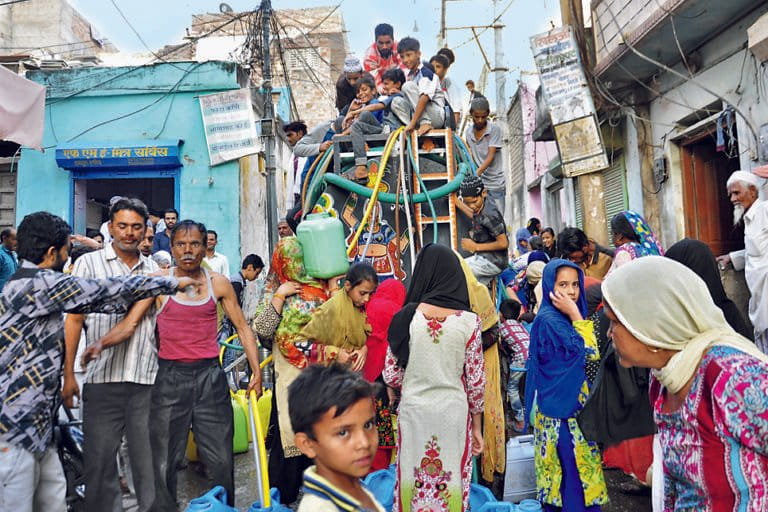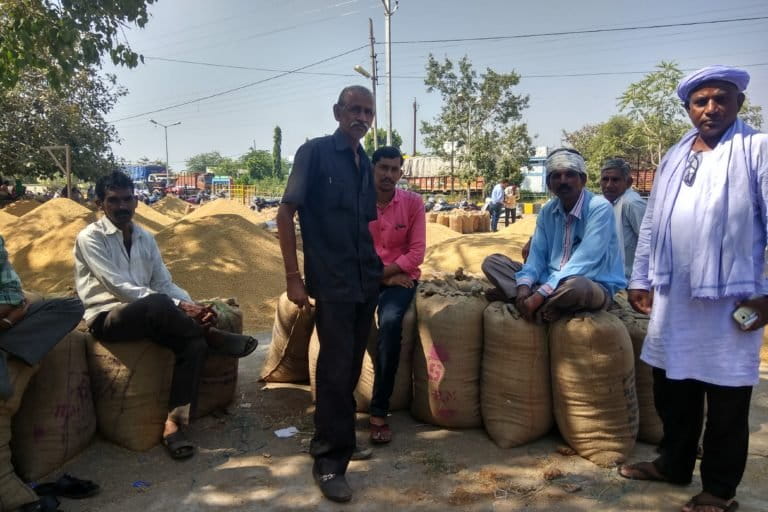- In a first of its kind series on environment and elections, Mongabay-India looked in depth at the environmental issues that had a strong recall in Chhattisgarh, Madhya Pradesh, Mizoram, Rajasthan and Telangana.
- While agriculture and water availability were prime issues in more than one state, mining, forests and tribal rights were the other important issues.
- Agrarian issues – caused mainly by environmental factors – are spilling over from the states into a national movement with two demonstrations having been organised in New Delhi and one in Mumbai in 2018.
- The narrative for the 2019 national elections could well be driven by environmental issues, just as how development drove the narrative for the 2014 elections.
On December 11, officials will open the seals of thousands of electronic voting machines from Chhattisgarh, Madhya Pradesh, Mizoram, Rajasthan and Telangana. Packed in those machines are the electoral fates of 679 assembly constituencies – 90 in Chhattisgarh, 230 in Madhya Pradesh, 40 in Mizoram, 200 in Rajasthan and 119 in Telangana.
In the past weeks, through the field reporting of our staff writer and contributors, we brought out the stories of how these elections impact the environment issues on the ground. They talked with local community and tribal leaders, environmental activists, political representatives and concerned citizens.
The aim of Mongabay-India’s Environment and elections series was not to predict who will win or what would be the political trends. That is for poll pundits and psephologists. Our stories brought out into the public discussions some of the important environmental issues affecting the state, and which are the key areas where these issues are affecting the constituencies.
[Click to explore] Map by Kartik Chandramouli
Natural resources, tribal rights and an agrarian crisis
Coal mining been an important part of Mongabay-India’s election coverage. Our staff writer Mayank Aggarwal travelled to Korba in Chhattisgarh and Singrauli in Madhya Pradesh – two locations where coal mines and thermal power plants have dominated people’s lives for decades. These stories show how even when these mines and power plants lead to ease in life in other parts of the country, in villages and towns surrounded by tailing hills and industrial chimneys life has gone from bad to worse.
Nature leaves strange footprints. The locations where biomass buried over millennia turn into coalfields are also those that have good forests and tribal communities above ground. Thus, the story of coal production and power generation is also one of deforestation and marginalisation of tribals.
In spite of enabling legislations such as the Panchayats Extension to Scheduled Areas (PESA) Act of 1996, which extends devolution of power to tribal-dominated areas of the country, and the Forest Rights Act of 2006, which gives tribal communities rights over the use of resources in the forests, these groups of people continue to feel marginalised in the mainstream process. So much so that in these elections, some tribals in Bastar region of Chhattisgarh have decided to go at it alone, not linked to any political party.
However, if there is an issue that could be the election clincher in Madhya Pradesh, it is the agrarian crisis. While agriculture contributes three-fourths of the employment in the heartland state of the country, it has been a victim of constant neglect. The strongest grouse against the incumbent government is that it did not do enough for the farmers. The farmers are clear even while supporting the opposition Congress – they will bring them down if they do not deliver on their promises.
In Mizoram, it is an agricultural issue of a different kind that is engaging people during the elections. The state government’s policy on shifting cultivation has caused discontentment due to improper implementation. The other issue is the sorry state of the Chite Lui river that flows through capital city Aizwal.
Chart by Kartik Chandramouli
Got the capital, but no water
Three out of the five states are products of bifurcation. In 2000 Chhattisgarh was carved out of the erstwhile Madhya Pradesh. In 2014 Telangana was carved out of the larger Andhra Pradesh state.
It was Chhattisgarh that had demanded to be separated from Madhya Pradesh. Tucked in the eastern part of then the largest state in the country, the people of Chhattisgarh wanted their own administration to take care of their needs. They had to build infrastructure worthy of a state capital at Raipur.
The case of Telangana was different. The capital city of Hyderabad came with the state that had demanded for bifurcation. Andhra Pradesh has to work to create a new capital at Amaravati. However, Telangana inherited one problem. It has big rivers such as Godavari and Krishna flowing through its territory, but they flow through deep valleys and most of the state is on the semi-arid Deccan Plateau. Andhra Pradesh inherited the large dam reservoirs.
Thus, drinking and irrigation water supply and the quality of tanks continue to be the major election issue in Telangana. And when the state is working to construct the big Kaleshwaram Lift Irrigation Project, there is strong people’s protest due to the environmental problems that it would generate. Telangana got the capital city but lost on the water infrastructure, and this issue came back to haunt the incumbent government in these elections.
Water and mines
It is no surprise that there is water shortage in Rajasthan. A state that occupies 11 percent of the Indian landmass and has access to only 2 percent of its water resources is perennially starved of water. But what is irking the citizens of the state government has been incapable of improving the situation over years. “This government is blind. It can’t see our pain,” said an anguished Raghubeer, a farmer in Karauli district of Rajasthan, in a video interview to Mongabay-India.
Silicosis, a fibrotic lung disorder that happens due to the constant inhalation of silica dust, is another serious environment and health problem in Rajasthan that has become an election issue. For thousands of labourers working in the stone quarries of Rajasthan, constant exposure to silica dust has caused their lungs to stiffen causing severe breathlessness and even untimely death. Ironically, this serious health problem is not even well documented, and the patients treated and compensated, even as the stones cut out by these men are used to make expensive buildings all over the country.
Unregulated mining is also a serious environmental problem in the Aravalli Hills, the geologically old and eroded mountain range that forms the last frontier between the desert and the plains. Even as the Supreme Court ordered Rajasthan to stop illegal mining, many hillocks in this range have disappeared over the years.

Why environment and elections?
Elections are the only time when even the most marginalised communities in the country have an opportunity to have their voices heard. However, ironically, even those environmental issues that had engaged the public and media discourse sometimes disappear during the election period. They are replaced by stories on coalitions and separations, trends, horse-trading, etc.
Partially, the reason for this could be because in India there is no political party – like the Greens in Europe – who bring in environment issues into the election processes. In the run up to the 2014 general elections, some members of the National Alliance of People’s Movements (NAPM) had agreed to contest with the Aam Aadmi Party (AAP). However, this collaboration did not make strong impact on the environmental front, for the party itself was restricted to Delhi after the elections.
Mongabay-India’s election coverage highlighted the dichotomy that India continues to be – while at one level the discussions are on developing the biggest and best for the country, at the ground level in many parts of the country the struggle continues for people’s access to their natural resources, and for their right to earn a livelihood and live with dignity.
Demanding access to natural resources and conserving them from over-exploitation has been the story of Indian environment history of the recent decades. In the 1970s when village women of Garhwal Himalayas hugged their native trees to prevent them from being cut and trucked away for industrial use during the Chipko movement, it was to protect their access to the natural resources. The story was the same in Silent Valley, the Narmada and Tehri valleys, Niyamagiri and the more recent problems related to the Sterlite copper smelter in Thoothukudi, where people living near the plant were asking for their right to clean air and water.
Many of the environmental issues surfacing even now have historical roots going back decades. The issue of mines go back to the planned industrialisation process that India started upon after in the early decades after Independence. Those were the days when the early thermal power plants, steel plants and similar heavy industries were established by the national government through public-sector companies. If fair and equitable policies had been institutionalised then, mining may not have become an unending trauma for those living in the resource-rich forests.
Similarly, the agrarian issues have their roots from the Green Revolution starting in the mid-1960s. The package of practices led to dramatic food productivity and turned the country self-sufficient and thus freed the people from the pressures of living from ship to mouth. However, since improved seeds plus fertilizers, pesticides and credit could work well only in the irrigated tracts, only one-third of the farmlands in the country benefited from it. The alacrity with which the government provided support to the irrigated tracts was missing in the case of the rain-fed and semi-arid tracts, which constitute two-thirds of the area of Indian agriculture.
While it was the State environmentally disenfranchising the local communities till the 1990s, the economic liberalisation process opened the access for their natural resources to national and international private industries and corporations. The environment costs of development got neglected. By 2014, nationalism was also added into the picture, making those raising environmental concerns anti-national in addition to being anti-development.

Environment and the 2019 national elections
The assembly elections in these five states are important for they are seen as an indication for what the trend would be in the upcoming national elections expected for mid-2019. Some political echoes from this period could return again closer to the national elections.
Considering that leaders of all opposition political parties joined the protest by farmers in New Delhi in the past week, it is possible that agrarian issues could resurface in the months to come. This is the second time such a march is culminating in New Delhi this year, and there was another one to Mumbai. In Delhi last week the farmers demanded a special session of Parliament to discuss and find answers that have been troubling the farming sector for decades.
Elections are a period of catharsis, where those without a voice for nearly five years find a voice. It is the time when voters articulate their concerns, and have a hope to be heard. When local and regional voices join to become a national voice before the elections, it can be surmised that the issues raised could become the national narrative for the elections.
The build up to the national narrative for the 2014 was the voice of the urban middle class voter asking for development. In 2019, environmental issues could very well be driving the narrative.
Banner image: India map by Google Earth Pro.
